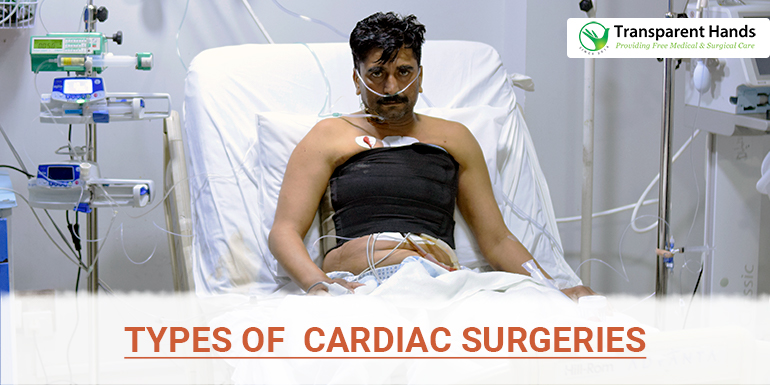Types of Cardiac Surgeries

The human heart is an incredible organ, tirelessly pumping life-sustaining blood throughout our bodies. Unfortunately, heart ailments can sometimes disrupt its vital functions. In such cases, medical intervention becomes necessary, and this often involves various types of cardiac surgeries. This article delves into the world of heart surgeries, exploring the different procedures that exist to address a range of cardiovascular conditions.
The Importance of Cardiac Surgeries
Cardiovascular diseases continue to be a leading cause of mortality worldwide. In response to this health crisis, medical science has developed a multitude of surgical techniques to treat heart conditions, aiming to restore normal cardiac function and improve patients’ quality of life.
Common Types of Heart Surgeries
1. Coronary Artery Bypass Grafting (CABG):
CABG, often referred to as “bypass surgery,” is a well-known procedure for treating coronary artery disease (CAD). This surgery involves creating new pathways for blood flow to the heart muscle, bypassing blocked or narrowed coronary arteries. By improving blood circulation, CABG can alleviate chest pain and reduce the risk of heart attacks.
2. Heart Valve Surgery:
This category encompasses various procedures aimed at repairing or replacing heart valves, such as the mitral valve, aortic valve, tricuspid valve, or pulmonary valve. Valve surgery is crucial for addressing issues like stenosis (narrowing) or regurgitation (leakage) of these valves. A well-functioning valve ensures proper blood flow through the heart.
3. Aortic Aneurysm Repair:
The aorta, the body’s main artery, can develop weakened or bulging areas called aneurysms. Surgical repair or replacement of the affected aortic segment is essential to prevent potentially life-threatening ruptures.
4. Congenital Heart Defect Repair:
Some individuals are born with heart defects. These may include atrial septal defects (ASD), ventricular septal defects (VSD), or other structural abnormalities. Surgery corrects these defects and allows the heart to function properly.
5. Heart Transplant:
A heart transplant is the ultimate solution for end-stage heart failure. In this complex surgery, a diseased or failing heart is replaced with a healthy donor heart. It’s a procedure that gives a second chance at life to those whose hearts can no longer support their bodies.
6. Left Ventricular Assist Device (LVAD) Implantation:
An LVAD is a mechanical pump surgically implanted in the chest to assist a weakened heart in pumping blood. It can serve as a bridge to transplant or as destination therapy for patients who are not eligible for heart transplantation.
7. Cardiac Ablation:
Cardiac ablation is a minimally invasive procedure used to treat arrhythmias, which are irregular heart rhythms. During this procedure, abnormal electrical pathways in the heart are destroyed or isolated to restore normal heart rhythm.
8. Percutaneous Coronary Intervention (PCI):
Commonly known as angioplasty or stenting, this procedure involves inserting a balloon catheter into narrowed coronary arteries to widen them and improve blood flow. A stent may be placed to keep the artery open.
9. Maze Procedure:
The maze procedure is employed to treat atrial fibrillation (AFib). It creates a pattern of scar tissue in the atria to redirect electrical impulses and restore a normal heart rhythm.
10. Ventricular Septal Defect (VSD) Repair:
This surgery repairs a hole in the wall that separates the heart’s lower chambers (ventricles), ensuring proper blood flow and preventing complications.
Transparent Hands & Heart Health
Our organization, in collaboration with Pakistan Children’s Heart Foundation, has been dedicated to serving patients who suffer from heart diseases. Through the generous donations of our donors, we help fund cardiac surgeries for the treatment of congenital cardiac defects as well as complex heart problems that develop later on in life.
The kind of cardiac procedures and surgeries that we have been able to conduct so far include angiography, angioplasty, coronary artery bypass graft (CABG) surgery, valve replacement surgeries and septal defects repair surgeries, etc. The patients who require surgical cardiac intervention usually need to be operated on an urgent basis. Consequently, we make sure that patients who are registered with us get timely medical assistance.
Changing Tiny Habits Might Save Your Life
The techniques used for the treatment of heart have been thoroughly researched and technological advancements have been made. Yet, prevention is always better than cure.
We need to mend our ways if we want to avoid chronic complications later on in life. The key risk factors that have been associated with cardiovascular diseases are a sedentary lifestyle, unhealthy dietary choices, and the use of tobacco and alcohol. These behaviors end up translating into high blood glucose and lipid levels, hypertension, and obesity. Small steps like making healthy dietary choices and maintaining an active lifestyle can help prevent numerous chronic diseases.
Conclusion
Cardiac surgeries encompass a wide array of procedures, each tailored to address specific heart conditions. These surgeries are a testament to medical progress, offering hope and healing to countless individuals with cardiovascular ailments. From bypassing blocked arteries to repairing heart defects, these surgical interventions play a crucial role in enhancing patients’ well-being and extending their lives.
As our understanding of heart health continues to evolve, so too will the techniques and technologies used in cardiac surgeries. These advancements will continue to reshape the landscape of heart surgery, offering new hope and improved outcomes for individuals with heart-related conditions.
Must Read:










Leave a Reply